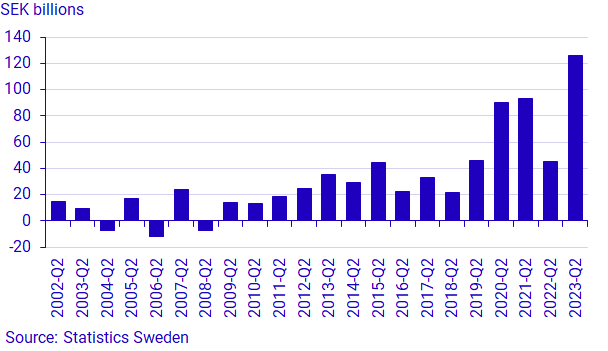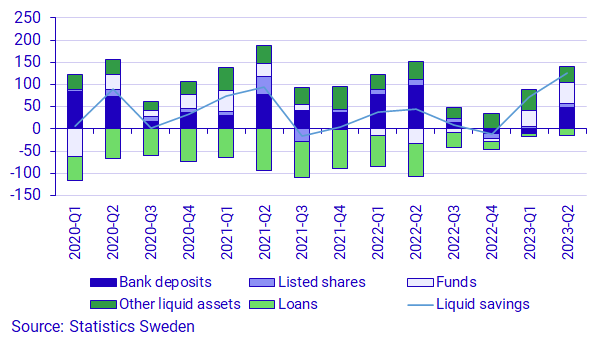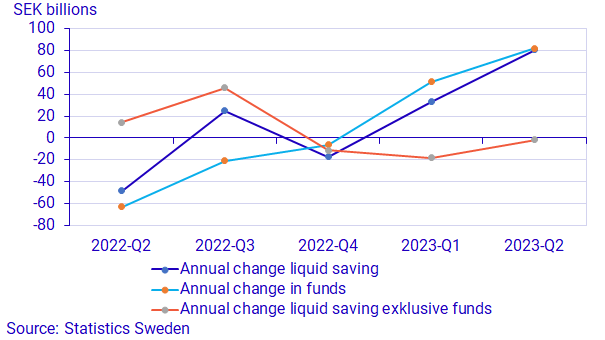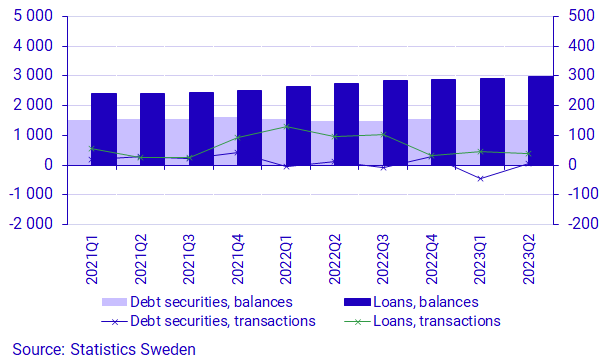Financial Accounts second quarter 2023
Household fund saving was high in the second quarter
Statistical news from Statistics Sweden 2023-09-21 8.00
Household liquid saving for the second quarter of 2023 was unusually high. The quarter was characterized by high fund saving, while net deposits in bank accounts were low and the growth rate in loans was close to zero.
Household liquid savings are usually at their highest in the second quarter of the year, when tax refunds and dividends are paid. Even taking this into account, household liquid savings for the second quarter of 2023 were unusually high and amounted to SEK 126 billion, which is SEK 81 billion higher than the corresponding quarter last year.

Household net bank deposits have halved in the second quarter of 2023 compared with the same quarter last year and amounted to SEK 49 billion. Net deposits in bank accounts have not been at such a low level for a second quarter in five years.
Household net borrowing, i.e. new loans minus amortization, has slowed down significantly over the past four quarters. In the second quarter, household net borrowing amounted to SEK 15 billion, which was SEK 60 billion lower than the corresponding quarter last year.

Household savings in fund shares were high and were measured at SEK 49 billion. It was mainly equity funds and other funds that contributed to the high fund savings, but bond and money market funds were also net bought during the quarter.
The diagram below shows the year-on-year change in household liquid savings, net transactions of funds and liquid savings excluding net transactions of funds. The year-on-year change in liquid savings and net transactions of funds follow each other from the second quarter of 2022. Liquid savings excluding net transactions of funds have had a negative trend over the past four quarters and this negative trend has strengthened since the end of 2022. Household savings in funds have consequently had a major positive impact on liquid savings during the first half of 2023.

Non-financial corporations continue to finance themselves through loans
In the second quarter of 2023, non-financial corporations financed themselves through loans, new loans minus amortisation, in monetary financial institutions (MFIs) to a value of SEK 38 billion. This is in line with the previous quarter, but lower than the corresponding quarter last year. Financing through debt securities was moderate and net issues, new issues minus maturities and repurchases, amounted to SEK 4 billion. It was higher than in the previous quarter but lower than in the corresponding quarter of the previous year. Total loans in MFIs amounted to SEK 2,964 billion at the end of the quarter. The value of issued debt securities amounted to SEK 1,523 billion.

Revisions
During the calculation of the second quarter of 2023, the annual and quarterly statistics have been revised for the period 1995–2022 and 1996Q1–2023Q1. A revised breakdown of assets and liabilities for the financial instrument F8900 Other accounts receivable/payable has been corrected for the entire time series. The rest of the world sector has been revised as of the first quarter of 2013 with new information from the Balance of Payments. Revisions of issued debt securities have been introduced for non-financial and financial companies from 2014 onwards. For municipalities and regions, the entire time series has been revised in terms of traditional pension entitlements due to changes in the discount rate. The revisions have been made for 2022 with a new source for the 2022 annual estimate. In addition, municipalities' financial leasing liabilities have been revised from 2017 onwards. The AP Funds holdings in foreign funds have been revised from the first quarter of 2019 onwards to follow the same definition as the Balance of Payments.
Definitions and explanations
The statistical news refers to the liquid savings of households. It is calculated as the difference between transactions in financial assets and liabilities excluding accruals (tax accruals, occupational pensions and other technical provisions). See the Financial Accounts Quality Declaration, section Variables 1.2.2, for more information.
The purpose of financial accounts is to provide information on financial assets and liabilities as well as changes in net lending and financial assets for different sectors of society. The statistics are presented at current prices and do not take inflation into account.
The net lending of financial accounts is calculated as the difference between transactions in financial assets and liabilities. In real Sector Accounts, which, like Financial Accounts, is part of National Accounts, net lending is calculated as the difference between income and expenses. However, financial accounts and real sector accounts are based on different sources, which gives rise to differences between products.
In Financial Accounts, public debt is calculated differently from the most commonly reported measure of government debt, which is calculated according to the convergence criteria, the so-called Maastricht debt. The definition of the Maastricht debt does not include all financial instruments, the instruments are presented at nominal value and the liabilities for government administration are consolidated. Central government debt in Financial Accounts is not consolidated and includes all financial instruments at market value.
In addition to central government, the state administration sector also includes certain state foundations and certain state-owned companies. State administration does not include units of the old-age pension system. Instead, they constitute the social security funds sector. Municipal administration includes primary municipal authorities, regional authorities (formerly county councils), municipal associations, as well as certain municipal foundations and certain municipally or regionally owned companies.
Further information: National wealth
In connection with the publication of Financial Accounts, the National Wealth Report is also published, which contains annual data on both real and financial assets. The financial assets and liabilities are derived from the Financial Accounts and are thus consistent with the values published in the Financial Accounts.
For further information, see:
Nationalförmögenheten och nationella balansräkningar (in Swedish) (pdf)
Next publishing will be
The next statistical news in this series is scheduled for publishing on 2023-12-14 at 08.00
Feel free to use the facts from this statistical news but remember to state Source: Statistics Sweden.
